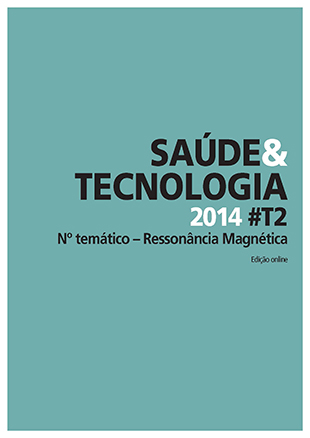Efeito fisiológico da cafeína em estudos neurológicos com base na ponderação em susceptibilidade ferromagnética (SWI)
DOI:
https://doi.org/10.25758/set.1074Palavras-chave:
SWI, Cafeína, CNR, Vasculatura venosaResumo
Introdução – O presente estudo avaliou o efeito da cafeína no valor da razão contraste ruído (CNR) em imagens SWI. Objetivos – Avaliar o efeito da cafeína qualitativamente e quantificado pelo cálculo do valor CNR em imagens de magnitude e MIP para as estruturas: veia cerebral interna, seio sagital superior, tórcula e artéria cerebral média. Metodologia – A população do estudo incluiu 24 voluntários saudáveis que estiveram pelo menos 24h privados da ingestão de cafeína. Adquiriram-se imagens SWI antes e após a ingestão de 100ml de café. Os voluntários foram subdivididos em quatro grupos de seis indivíduos/grupo e avaliados separadamente após decorrido um intervalo de tempo diferente para cada grupo (15, 25, 30 ou 45min pós-cafeína). Utilizou-se um scanner Siemens Avanto 1,5 T com bobine standard de crânio e os parâmetros: T2* GRE 3D de alta resolução no plano axial, TR=49; TE=40; FA=15; FOV=187x230; matriz=221x320. O processamento de imagem foi efetuado no software OsiriXâ e a análise estatística no GraphPadPrismâ. Resultados e Discussão – As alterações de sinal e diferenças de contraste predominaram nas estruturas venosas e não foram significantes na substância branca, LCR e artéria cerebral média. Os valores CNR pré-cafeína diferiram significativamente do pós-cafeína nas imagens de magnitude e MIP na veia cerebral interna e nas imagens de magnitude do seio sagital superior e da tórcula (p<0,0001). Não se verificaram diferenças significativas entre os grupos avaliados nos diferentes tempos pós-cafeína. Conclusões – Especulamos que a cafeína possa vir a ser usada como agente de contraste nas imagens SWI barato, eficaz e de fácil administração.
Downloads
Referências
Reichenbach JR, Venkatesan R, Schillinger DJ, Kido DK, Haacke EM. Small vessels in the human brain: MR venography with deoxyhemoglobin as an intrinsic contrast agent. Radiology. 1997;204(1):272-7.
Haacke EM, Mittal S, Wu Z, Neelavalli J, Cheng YC. Susceptibility-weighted imaging: technical aspects and clinical applications, part 1. AJNR Am J Neuroradiol. 2009;30(1):19-30.
Reichenbach JR, Haacke EM. High-resolution BOLD venographic imaging: a window into brain function. NMR Biomed. 2001;14(7-8):453-67.
Santhosh K, Kesavadas C, Thomas B, Gupta AK, Thamburaj K, Kapilamoorthy TR. Susceptibility weighted imaging: a new tool in magnetic resonance imaging of stroke. Clin Radiol. 2009;64(1):74-83.
Reichenbach JR. Recent advances in SWI. In Cost B21 - Physiological Modelling of MR Image Formation, Szeged (Hungary), 18th March 2005. Available from: http://www.die.upm.es/costb21/docs/MeetingMar2005/WG1_Szeged_Pres.pdf
Sedlacik J, Helm K, Rauscher A, Stadler J, Mentzel HJ, Reichenbach JR. Investigations on the effect of caffeine on cerebral venous vessel contrast by using susceptibility-weighted imaging (SWI) at 1.5, 3 and 7 T. Neuroimage. 2008;40(1):11-8.
Chen Y, Parrish TB. Caffeine's effects on cerebrovascular reactivity and coupling between cerebral blood flow and oxygen metabolism. Neuroimage. 2009;44(3):647-52.
Araújo MC. Efeito de estimulantes na marcha e postura humana: caso da cafeína [Dissertation]. Porto: Faculdade de Engenharia da Universidade do Porto; 2011. Portuguese
Alves RC, Casa S, Oliveira B. Benefícios do café na saúde: mito ou realidade? [Health benefits of coffee: myth or reality?]. Quím Nova. 2009;32(8):2169-80. Portuguese
Rosset A, Spadola L, Ratib O. OsiriX: an open-source software for navigating in multidimensional DICOM images. J Digit Imaging. 2004;17(3):205-16.
Edelstein WA, Bottomley PA, Hart HR, Smith LS. Signal, noise, and contrast in nuclear magnetic resonance (NMR) imaging. J Comp Assist Tomogr. 1983;7(3):391-401.
Haacke EM, Hu C, Parrish TB, Xu Y. Whole brain stress test using caffeine: effects on fMRI and SWI at 3T. Proc Intl Soc Magn Reson Med. 2003;11:1731.
Downloads
Publicado
Edição
Secção
Licença
Direitos de Autor (c) 2022 Saúde & Tecnologia

Este trabalho encontra-se publicado com a Licença Internacional Creative Commons Atribuição-NãoComercial-SemDerivações 4.0.
A revista Saúde & Tecnologia oferece acesso livre imediato ao seu conteúdo, seguindo o princípio de que disponibilizar gratuitamente o conhecimento científico ao público proporciona maior democratização mundial do conhecimento.
A revista Saúde & Tecnologia não cobra, aos autores, taxas referentes à submissão nem ao processamento de artigos (APC).
Todos os conteúdos estão licenciados de acordo com uma licença Creative Commons CC-BY-NC-ND. Os autores têm direito a: reproduzir o seu trabalho em suporte físico ou digital para uso pessoal, profissional ou para ensino, mas não para uso comercial (incluindo venda do direito a aceder ao artigo); depositar no seu sítio da internet, da sua instituição ou num repositório uma cópia exata em formato eletrónico do artigo publicado pela Saúde & Tecnologia, desde que seja feita referência à sua publicação na Saúde & Tecnologia e o seu conteúdo (incluindo símbolos que identifiquem a revista) não seja alterado; publicar em livro de que sejam autores ou editores o conteúdo total ou parcial do manuscrito, desde que seja feita referência à sua publicação na Saúde & Tecnologia.







